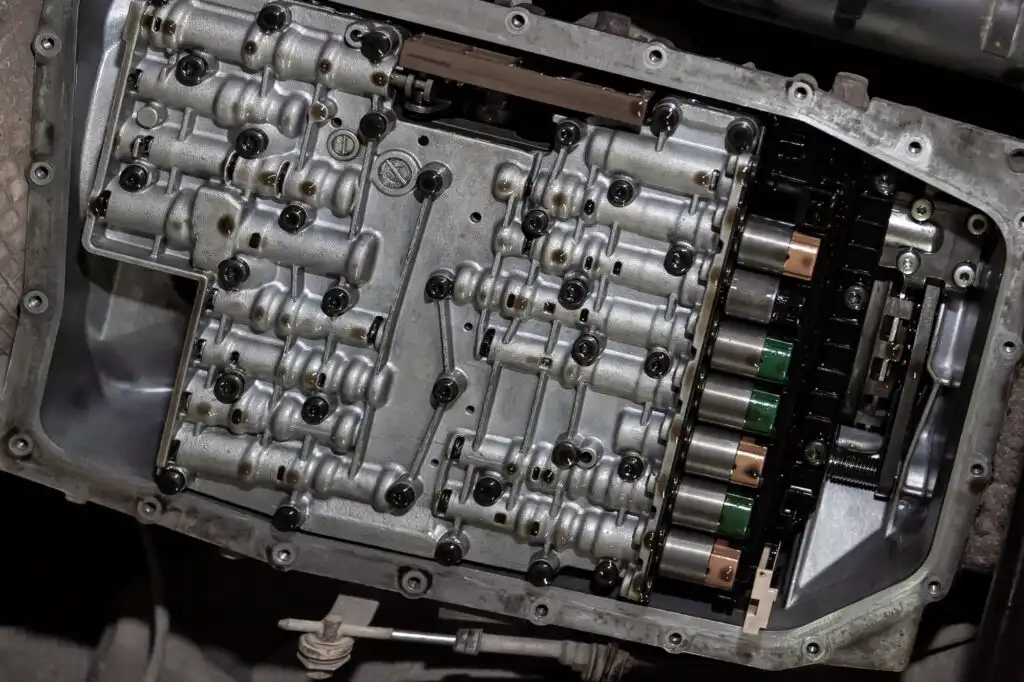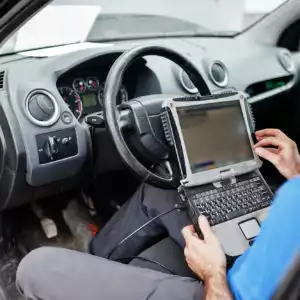Your vehicle’s transmission system transfers power from the engine to the driveshaft and differential so that your wheels can turn efficiently. Without a fully-functioning transmission, your car can’t go anywhere. A critical component in this system is called a transmission solenoid.
What Is a Transmission Solenoid?
The transmission solenoid or transmission shift solenoid is an electro-hydraulic valve. Usually made of steel, it controls the flow of transmission fluid so that your ride can change gears smoothly.
How Do Transmission Shift Solenoids Work?
In an automatic transmission, the transmission control module (TCM) gets data from your engine and speed sensors. It then analyzes the best time to shift gears using the data.
After that, the TCM sends power or ground to the shift solenoids so that fluid can flow into the valve body. The flow of transmission fluid alters hydraulic pressure, allowing your vehicle to shift gears.
Vehicles equipped with a manual transmission don’t have shift solenoids. Instead, a manual clutch controls gear shifting.
How to Access Transmission Solenoids

On some vehicles, the shift solenoids can be serviced without removing the valve body, while in others, the valve body must be removed to access and service these components.
Take note that this information may not be found in your owner’s manual. If you’re not a seasoned DIYer, and you’re not familiar with shift solenoids, it’s best to consult a trusted mechanic.
How Many Solenoids Are In a Transmission?
The exact number of transmission solenoids your daily driver has depends on its specific make and model. A vehicle with an automatic transmission usually has two to five shift solenoids. Each solenoid plays a vital role in controlling fluid flow, making it possible to shift gears.
What Causes a Transmission Solenoid to Malfunction?
Transmission shift solenoids are durable, but that doesn’t mean they’re immune to malfunction. Here are some of the reasons why your solenoids can get faulty:
Natural Wear
Like any other valve, your transmission solenoids can wear out over time. Although proper maintenance can significantly prolong their lifespan, replacing them might be inevitable as your ride ages.
Electrical Issues
Your solenoids rely on electrical signals, which make them prone to electrical malfunctions. For example, if an incorrect voltage is supplied to the coil (too high or too low), it can damage the coil and the solenoid itself. Also, the windings inside the shift solenoid can just fail.
Contaminated Transmission Fluid
A dirty transmission fluid can clog your solenoid. Once this happens, the solenoid can get stuck open or stuck close. Make sure to check the condition of your ride’s transmission fluid regularly to avoid any mishaps.
How Long Does a Transmission Solenoid Last?
The lifespan of a transmission solenoid will depend on factors like the part’s quality and how hard it’s used. But if you’re looking for an estimate, you can expect a shift solenoid to last around 50,000 miles before it’ll need to be replaced.
Symptoms of a Bad Transmission Solenoid
Here are some of the symptoms that can signal it’s time to take your ride to an auto repair and have your solenoids inspected:
Delayed Shifting
If you’ve observed delayed shifting, there’s a chance that one or more solenoids are starting to malfunction. That’s because a solenoid malfunction can cause the transmission to shift sluggishly.

Skipping Gears
If one solenoid is damaged or worn out, your ride might have issues engaging the “problem gear.” Vehicles usually have several solenoids for each gear. Once one is faulty, they can’t shift to that gear. Instead, they’ll jump to the next gear.
Getting Stuck In Specific Gears
If your solenoid got damaged while a gear was engaged, your transmission might get stuck in that gear. Some shops might try to release the gear using external power. However, a good shop won’t do that. It’s best to find the root cause of the issue and fix it. A thorough inspection will be needed
Hard Shifting
Solenoid issues can make shifting to another gear difficult. There might be times when you can shift upward from one gear to the other, but you can’t shift back down. A solenoid that’s stuck in an open position could be the culprit.
Activated Limp Mode
Limp mode is a protective feature that reduces the speed when it detects issues in the engine and the transmission (like a faulty transmission solenoid). It could also trigger some components to stop working in the meantime. Once limp mode is activated, the engine’s RPM will only go anywhere between 2,500 and 3,500.
It’s important to note that your transmission will go into second gear, and it won’t shift to any other gear once limp mode is activated. Most of the time, once you turn off your vehicle and completely shut off the ignition, limp mode will not be activated until the vehicle’s computer detects another malfunction. That’s if the condition wasn’t detected right away.
Illuminated Transmission Warning Light
Many vehicles have indicators to warn the drivers in case there’s a solenoid or transmission issue. They include the transmission warning light and check engine light, which illuminate when the TCM detects a problem with one or more solenoids.
Is It Safe to Drive With a Bad Solenoid?
You can still drive your vehicle even if it has a malfunctioning transmission solenoid. However, it isn’t recommended. Driving with a bad transmission solenoid can damage your transmission even more, leading to costly repairs.
It’s best to take your ride to an auto repair shop once you notice any of the symptoms of a bad transmission solenoid. Mechanics can diagnose the issue, determine whether it’s due to a faulty solenoid, and conduct the necessary repairs or replacements. You can get back on the road in no time.
How Much Does a Shift Solenoid Replacement Cost?
The exact cost of a transmission solenoid replacement depends on its brand and your vehicle. A typical transmission solenoid can range anywhere between $15 and $100. Expect to spend $60 to $350 for labor.
Replacing a solenoid can be complicated. Some experienced mechanics take around two to four hours to replace the solenoid. If you leave the task to an expert, remember that labor rates can vary depending on the state where you’re at.
Any information provided on this Website is for informational purposes only and is not intended to replace consultation with a professional mechanic. The accuracy and timeliness of the information may change from the time of publication.




























